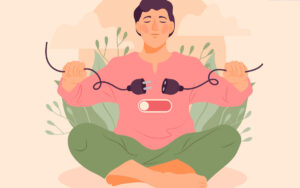As the seasons change, many people experience shifts in mood, energy, and well-being. The colder months and shorter days, often associated with cozy rituals and festive gatherings, can also bring about feelings of sadness, grief, or emotional overwhelm.
Whether it’s Seasonal Affective Disorder (SAD) or the resurfacing of grief during holidays, these emotional states are more than just a mental struggle—they manifest physically, impacting your energy and daily routines.
At Gloow.care, we understand that well-being isn’t just about your mental state; it’s about the way your body, mind, and daily habits connect.
In times of emotional hardship, turning to somatic exercises can help you ground yourself, reconnect with your body, and foster self-healing.
Here are five holistic practices that blend ancient wisdom with modern mindfulness to help ease seasonal depression and grief.
Key Benefits of Somatic Practices:
- Reconnects the body with emotions, helping to process grief and depression physically.
- Grounds the mind through breathwork, promoting calm and focus.
- Improves daily functioning by nurturing self-compassion and easing tension.
- Reduces feelings of overwhelm through gentle movement and relaxation techniques.
Oceanic Breathwork to Start Your Day
Morning can feel especially challenging when facing depression or grief, as getting out of bed and completing basic tasks might seem overwhelming. Starting your day with oceanic breathwork—a soothing, rhythmic breathing pattern—can help anchor your mind and body, allowing you to take on your day one step at a time.
How to Practice Oceanic Breath:
Sit or lie down in a comfortable position. With your mouth slightly open, inhale deeply, allowing your chest and diaphragm to rise. Exhale through your mouth, making a soft, ocean-like sound. Continue this pattern, focusing on the rise and fall of your breath. You can close your eyes to deepen the experience. Begin with 3-5 minutes, gradually extending it as you feel more comfortable.
This breathwork promotes relaxation by calming the nervous system, helping you stay present, and encouraging completion of simple daily tasks like showering or preparing a meal.

Nasal Breathing with Mindful Walking
Walking is one of the simplest ways to reconnect with your body, and when paired with intentional nasal breathing, it becomes a powerful tool for processing emotions. This practice helps clear mental clutter, allowing you to focus on your breath and movement instead of your thoughts.
How to Practice:
Find a quiet space for a slow, mindful walk. As you walk, begin to notice your natural breathing pattern. Gradually deepen your inhales and exhales, breathing through your nose. As you move, slow your breath further, extending each inhale and exhale by a few seconds. Focus on how your body feels with each step, grounding yourself in the present moment.
This practice helps reduce anxiety, creates space for emotional processing, and promotes a sense of calm, allowing difficult feelings to surface gently.
Self-Soothing Touch for Comfort and Grounding
Grief and depression often manifest physically, particularly in areas like the chest or stomach, where we tend to store emotional pain. Engaging in self-touch can be a nurturing way to release tension and foster a sense of safety in your body.
How to Practice:
Sit or lie down comfortably. Place your hands over areas of tension, like your chest or abdomen. Gently rub the area in a circular motion—first clockwise, then counterclockwise. As you do this, breathe deeply and allow your body to relax into the surface beneath you. For added comfort, swaddle yourself in a soft blanket or use a weighted blanket to promote a feeling of safety.
Touch activates the body’s natural “calm” response, helping you feel supported and more connected to yourself during emotional waves.

Grounding Through Yoga
Yoga, an ancient practice of mind-body connection, can be incredibly grounding during periods of emotional difficulty. Certain yoga poses help release tension stored in the hips and pelvis, while others create space for deeper breathing and calm the mind.
Holistic Yoga Practice:
Start with gentle poses like child’s pose, which provides a sense of protection and comfort, or bridge pose, which opens the chest and promotes deeper breathing. You can also practice seated forward folds to calm the mind and release tension in the lower back. Focus on long, slow breaths as you move through these poses, allowing yourself to sink into each stretch.
Yoga helps regulate the nervous system, encouraging balance between emotional and physical states, making it a great practice for navigating grief and sadness.

Aromatherapy and Breathwork for Emotional Release
Combining aromatherapy with breathwork can deepen the healing effects of both practices. Essential oils like lavender, frankincense, and rose can help calm the mind, ease anxiety, and support emotional release.
How to Practice:
Use a diffuser or apply a few drops of essential oil to a tissue. Begin by sitting comfortably and inhaling deeply through your nose, focusing on the soothing aroma. Exhale slowly and fully. Pair this with simple breathwork like box breathing—inhale for 4 seconds, hold for 4, exhale for 4, and hold for 4 again. Repeat for several cycles, allowing the aroma to enhance your sense of calm.
Aromatherapy paired with breathwork offers a gentle way to soothe emotional discomfort and promote self-healing during times of seasonal transition and grief.
At Gloow.care, we believe that healing involves more than just mental strategies—it’s about addressing the body, mind, and spirit as a whole.
By incorporating these somatic practices into your daily life, you can nurture yourself through difficult times, whether it’s seasonal depression or grief. Remember, self-care starts with gentle, compassionate awareness of your needs.
Let these practices guide you toward a deeper sense of balance and connection during challenging seasons.



































